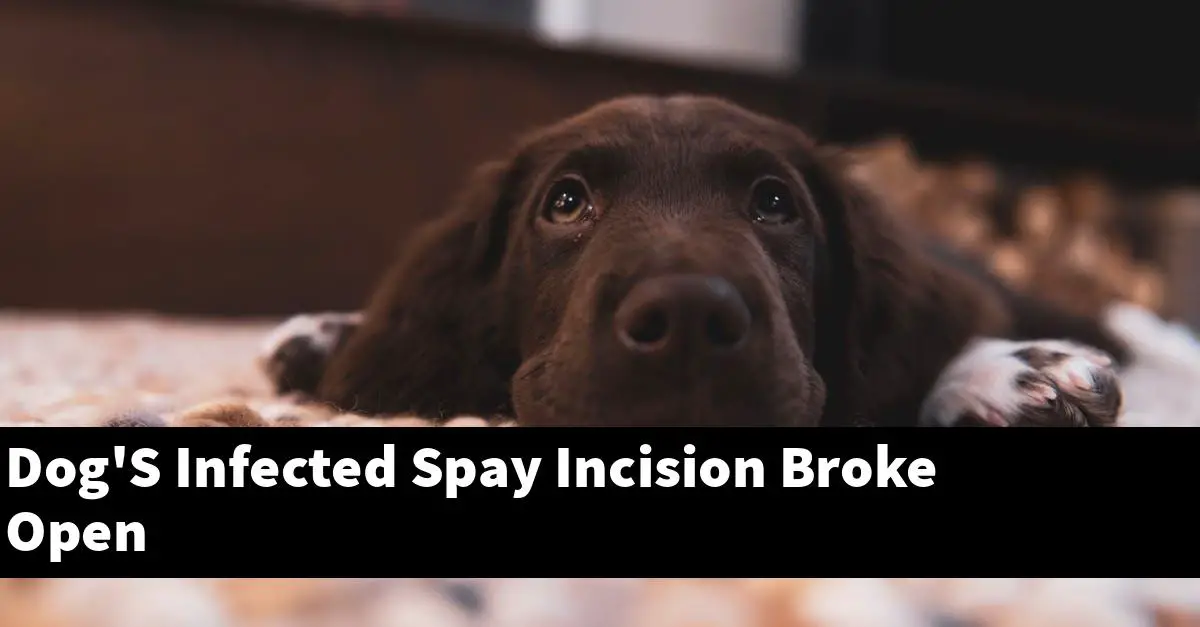A dog’s spay incision can become infected if the wound is not properly cared for. If the infection is severe, the incision may break open.
The article covers the story of a dog who got an infection after being spayed and how the owner had to take care of it.
Table of Contents
How can I tell if my dog’s spay incision is infected?
If your dog’s spay incision is red, warm to the touch, or oozing pus, it may be infected. If your dog is also acting lethargic or has a fever, these could also be signs of an infection. If you think your dog’s spay incision may be infected, it’s important to take her to the vet right away. The vet will be able to determine if the incision is infected and prescribe the appropriate treatment.
What are the signs of an infected spay incision in a dog?
If your dog has been spayed, it is important to keep an eye on the incision site to ensure that it is healing properly. Here are some signs that the incision may be infected:
- Redness or swelling around the incision
- Discharge from the incision
- Odor coming from the incision
- Your dog is licking or biting at the incision
- Your dog seems to be in pain
If you notice any of these signs, it is important to take your dog to the vet to have the incision checked out. The vet may prescribe antibiotics if the infection is severe.
How can I prevent my dog’s spay incision from becoming infected?
The most important thing you can do to prevent your dog’s spay incision from becoming infected is to keep the area clean and dry. You will need to clean the area around the incision twice a day with mild soap and warm water.
Be sure to Pat the area dry after cleaning. You should also avoid letting your dog swim or bath for two weeks after the surgery. If the incision does become wet, dry it off immediately.
You will also need to keep an eye on the incision for any signs of infection. Look for redness, swelling, or discharge from the incision. If you see any of these signs, contact your veterinarian immediately.
Finally, make sure your dog is not licking or scratching at the incision. You may need to use an Elizabethan collar (cone) to prevent your dog from reaching the incision.
By following these simple steps, you can help prevent your dog’s spay incision from becoming infected.
What should I do if my dog’s spay incision breaks open?
If your dog’s spay incision breaks open, it is important to take them to the vet as soon as possible. The vet will be able to clean the wound and determine if it needs to be re-stitched. If the wound is not too severe, they may be able to treat it with antibiotics.
What happens if a spay incision opens?
When a spay incision opens, it is called dehiscence. This can happen for a number of reasons, including infection, poor healing, or trauma to the area. If the incision is small, it may heal on its own.
However, if the incision is large or if there is any concern for infection, veterinary care should be sought. Treatment will likely include antibiotics and may require surgery to close the incision.
How do vets treat an infected spay incision?
The most common reason for an infected spay incision is bacteria entering the wound during or after surgery. The bacteria can come from the skin, the hair, the environment, or contaminated instruments. The risk of infection is greatest in the first few days after surgery, but it can occur anytime during the healing process.
The most common signs of an infected spay incision are redness, swelling, and discharge. The incision may also be hot to the touch. If the infection is severe, the dog may have a fever.
If you notice any of these signs, take your dog to the vet immediately. The vet will clean the wound and prescribe antibiotics. In severe cases, surgery may be necessary to remove all of the infected tissue.
How do you know if a dog’s incision is open?
If you’re concerned that your dog’s incision may be open, there are a few things you can look for. First, check the incision for any signs of redness, swelling, or discharge. If the incision appears to be healing properly, it should be dry and free of any discharge.
Secondly, feel around the incision to see if there is any heat or tenderness. If the incision is healing properly, it should not be hot to the touch or overly tender.
Finally, try to gently pull on the edges of the incision. If the incision is healing properly, the edges should be snug against the skin and should not pull apart easily. If you’re still unsure, it’s always best to err on the side of caution and contact your veterinarian.
What should I do if my dog’s incision is infected?
If your dog’s incision is infected, you should contact your veterinarian as soon as possible. They will likely recommend that you bring your dog in for an examination and may prescribe antibiotics.
Infections can occur even if the incision is healing properly, so it is important to have it checked out. If you notice any redness, swelling, or discharge from the incision, please contact your veterinarian right away.
Conclusion
If your dog’s spay incision is red, warm to the touch, or oozing pus, it may be infected. If your dog is also acting lethargic or has a fever, these could also be signs of an infection. If you think your dog’s spay incision may be infected, it’s important to take her to the vet right away.


